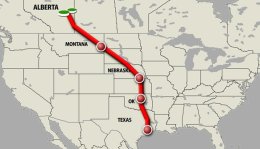 The US State Department issues its long-awaited report Friday on the proposed 1,700-mile Keystone XL pipeline from Alberta, Canada to gulf coast refineries in Texas. The State Department report said the pipeline would not substantially worsen greenhouse gas pollution. Once it’s built, the pipeline could carry 830,000 barrels of oil a day; the report says that this volume of oil would still be extracted from oil sands fields in Alberta and delivered to US refineries to have the oil extracted by rail instead.
The US State Department issues its long-awaited report Friday on the proposed 1,700-mile Keystone XL pipeline from Alberta, Canada to gulf coast refineries in Texas. The State Department report said the pipeline would not substantially worsen greenhouse gas pollution. Once it’s built, the pipeline could carry 830,000 barrels of oil a day; the report says that this volume of oil would still be extracted from oil sands fields in Alberta and delivered to US refineries to have the oil extracted by rail instead.
Here are a few points I would make about this decision:
- President Obama is likely to support the 1,700-mile Keystone pipeline; in a speech last summer, he said his administration would approve the pipeline if it didn’t “significantly exacerbate” the problem of greenhouse gas emissions. Secretary of State John Kerry is in a tough position as he studies his department’s 11-volume report and issues a statement about it in weeks or months ahead. Kerry has been a clear advocate of fighting climate change, and many significant environmental leaders are putting the pressure on Kerry and Obama to reject the Keystone pipeline.
- The US has been working hard on reducing imports of foreign oil in recent years, and this is one way it’s being done. Canada is, by far, the largest provider of foreign oil imports to the US, and Mexico is also one of the top suppliers of oil to the US. The Mexican government recently passed a sweeping energy reform bill allowing foreign investors in their market instead of the state-run oil giant controlling all of it. The Keystone pipeline, changes in the Mexican regulatory environment, and substantial growth in US oil and gas fields, means that there’s more oil coming to this country from North America and not from OPEC countries. Canada and Mexico are NAFTA partners and are much closer than other markets in the Middle East, Africa, and South America. Shipping the oil is faster and cheaper than from other markets, and the US has strong alliances with these two neighboring countries.
- Gasoline and diesel prices have been softening in the US and they should stay down this year. As mentioned above, the oil supply in North America is growing and that’s likely to keep prices down. That’s also likely to have some effect on market demand for electric vehicles, hybrids, and alternative fuel vehicles that usually cost more than comparable gasoline-engine vehicles. If you look at the surveys and marketing campaigns for green vehicles, gasoline prices are usually a top issue. That will need to change to get average consumers interested in making that purchase. Early adopters already own their green cars, and now it will probably take a revised marketing message to grow the market. Long-term cost savings and environmental benefits (emissions reductions) usually go over well with consumers, fleets, and transportation companies.




There is a cost trade study I am missing.
I do not see how it can’t be cheaper to build oil refineries in Montana, than to build and maintain a 1700 mile pipeline.
Can you find that piece of data?
When are the people going to start thinking more about the environment? Its blatently clear that we are in a global warming crisis and yet the greed of a few seem to try and justify this pipeline. Why don’t we vote on it? That would shut the whole thing down in a hurry. I mean isent this all about what the common people want? Should not everyone one the planet have a say? Rather than just a few near sighted greedy people who care less of their grandchildrens well being? We cant eat oil ! we need to look after our planet, that’s number one!